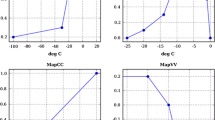Abstract
Numerical weather prediction data, in this study, were proposed to replace the meteorological measurement data acquired by widely used radiosonde, for the purpose of constructing atmospheric environment model applying to post flight analysis, especially evaluating aerodynamic performance in flight. KLAPS (Korea Local Analysis and Prediction System), the numerical weather model used in this study, is provided by the Korea Meteorological Administration every hour through the Internet and contains the meteorological information for a local region around the Korean peninsula, which is expected to give some advantage in the acquisition of regional and temporal variation of atmosphere state over the radiosonde measurement which has some drawbacks of acquiring data on only one point at one height while drifting via wind and taking some hours to climb up to 30 km high. The accuracy of KLAPS was verified by regenerating vertical distributions of atmospheric properties at the same locations and times as radiosonde measured and comparing them. Post flight analysis was carried out with an atmosphere environment model based on KLAPS and proved that the numerical weather model can provide an accurate atmospheric environment model enough to substitute the radiosonde measurement data.

















Similar content being viewed by others
Change history
10 April 2022
Reference 5 has been updated
References
Li Y, Si H, Zong Y, Wu X, Zhang P, Jia H, Xu S, Tang D (2021) Application of neural network based on real-time recursive learning and Kalman filter in flight data identification. Int J Aeronaut Space Sci 22:1383–1936. https://doi.org/10.1007/s42405-021-00380-0
Kim YH, Park KB, Roh JH, Hyun KL, Song YK (2011) Parameter Estimation of a skid-to-turn missile. In: Proceeding of the Korean Society for Aeronautical and Space Sciences Fall Conference, November, 2011, pp 257–262
Kang KT, Lee JK, Lee KS, Sun C (2012) Aerodynamic coefficient identification of missile from flight test. In: Proceeding of the 7th National Congress on Fluids Engineering, August, 2012, pp 453–454
Lee D, Im J, Lee H, Jung Y, Jeong J, Shin J, Lee S, Park JH, Ahn J (2020) Modeling and simulation of aircraft motion for performance assessment of airborne aesa radar considering wind and vibration. J Korean Soc Aeronaut Space Sci 48(11):903–910. https://doi.org/10.5139/JKSAS2020.48.11.903
Kim S, Choi H (2021) A telemetry-based post-flight wind profile estimation method for air-to-surface missile. Int J Aeronaut Space Sci 22:687–702. https://doi.org/10.1007/s42405-020-00328-w
Park Y, Park CG (2019) Robust filter based wind velocity estimation method for unpowered air vehicle without air speed sensor. J Korean Soc Aeronaut Space Sci 47(2):107–113. https://doi.org/10.5139/JKSAS.2019.47.2.107
Wuest W (1980) Pressure and flow measurement. AGARD-AG-160, AGARDograh No. 160, Vol. 11
Tactics, Techniques, and Procedures for Field Artillery Meteorology, Field Manual (FM 3-09.15), Headquarters, Department of the ARMY, October, 2007
Choi J, Cho S, Sun B (2018) Design of launch decision conditions considering day-of-launch upper winds. In: Proceeding of The Korean Society for Aeronautical and Space Sciences Fall Conference, November, 2018, pp 898–899
Kim ES, Park YS, Sin HW (2009) The implementation of weather measurement system to support weapon test. In: The Korean Institute of Military Science and Technology Annual Conference Proceedings 2009, Aug. 2009, Jeju, Korea, pp 28–29
Blaha M, Potuzak L (2013) Meteorological reports in the perspective automated artillery fire support control system. In: Proceeding of the 2013 International Conference on System, Control, Signal Processing and Informatics, 16–19, Jul. 2013. Rhodes Island, Greece, pp 289–295
Karlgaard CD, Kutty P, O’Farrell C, Blood E, Ginn J (2019) Reconstruction of atmosphere trajectory, and aerodynamics for the low-density supersonic decelerator project. J Space Rockets 56(1):221–240. https://doi.org/10.2514/1.A34223
Karlgaard CD, Tynis JA, O’Farrell C, Sonneveldt B (2019) Reconstruction of the advanced supersonic parachute inflation research experiment sounding rocket flight tests with strengthened disk-gap-band parachute. In: AIAA SciTech 2019, AIAA Atmospheric Flight Mechanics Conference, AIAA Paper 2019-0014
Jung SY, Lee JE, Kim MG (2019) Construction of atmosphere environment on flight trajectory using numerical meteorology model data. In: Proceeding of The Korean Society for Aeronautical and Space Sciences Spring Conference, April, 2019, pp 1–2
Kim SG, Kim HI, Lee SC (2015) Acquisition and application of weather information for high altitude flight test. In: Proceeding of The Korean Society for Aeronautical and Space Sciences Fall Conference, November, 2015, pp 959–962
Lee JH, Lee JE, Jung SY (2015) Construction of atmosphere environment in flight region using KLAPS data. In: Proceeding of The Korean Meteorological Society Spring Conference. No. 4, April 2015, pp 79–80
Noh YC, Son BJ, Kim YJ, Joo SW, Bell W (2015) Numerical weather prediction model analysis confirmation using radiosonde measurement data. In: Proceeding of The Korean Meteorological Society Spring Conference. No. 6, April 2015, pp 216–217
National Center for Meteorological Supercomputing, Issued Number 11-1360000-000852-01, NCMS, 2015
Lee JE, Kim MK, Kang EJ, Jung SY (2017) Program for atmosphere condition generation using KLAPS for missile performance analysis. In: ADDS-2017-0566, Agency for Defense Development, December, 2017
Lataitis RJ (1993) Theory and application of a radio-acoustic sounding system (RASS). In: NOAA Technical Memorandum ERL WPL-230, Wave Propagation Laboratory, April, 1993
Author information
Authors and Affiliations
Corresponding author
Additional information
Publisher's Note
Springer Nature remains neutral with regard to jurisdictional claims in published maps and institutional affiliations.
Rights and permissions
About this article
Cite this article
Jung, S.Y., Lee, J.E., Kim, MG. et al. Post Flight Analysis Using Numerical Weather Prediction Data, KLAPS. Int. J. Aeronaut. Space Sci. 23, 434–445 (2022). https://doi.org/10.1007/s42405-022-00453-8
Received:
Revised:
Accepted:
Published:
Issue Date:
DOI: https://doi.org/10.1007/s42405-022-00453-8




